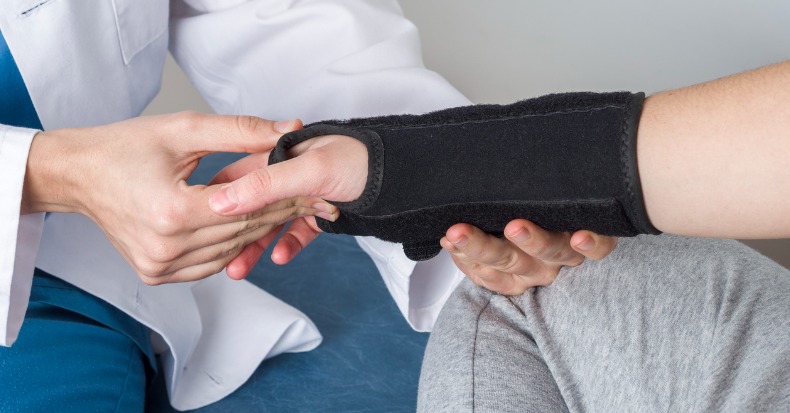When patients present for treatment of carpal tunnel syndrome (CTS), one of the most common treatments rendered is the use of a wrist brace, often referred to as a cock-up splint. The focus of this article is to explain the reasons why these braces are so commonly included in the management of CTS and why they work.
CTS is caused by anything that applies pressure on the median nerve (see #9 in C, D & E below) in a tight space called the carpal tunnel (see A & B below). The tunnel is made up of 8 bones that form the “U” shaped part of the tunnel while the floor or bottom of the tunnel is made up of a ligament called the transverse carpal ligament. There are also 9 tendons (tendons are structures that attach muscles to bones) and their coverings or sheaths that are needed to reduce friction as the tendons slide back and forth, such as when our fingers type on a computer, open the lid of a jar, lift a suitcase, hold a pen or pencil when writing, open a door knob, button a shirt… the list goes on and on! If the tendons didn’t have a sheath to slide in, the friction would build up too quickly, causing swelling and pain from tendonitis. The sheath provides lubrication as it creates an oil-like substance called synovial fluid which allows for the smooth slip and slide property of the tendon inside the sheath.
To illustrate this, turn your palm upwards and look at your wrist. Move your fingers as if you were typing on a computer or playing a piano. Look at all that movement that occurs at your wrist! Keep doing that and look at your forearm between the wrist and elbow. Do you see all the movement that is going on? As the muscles located in the upper part of our forearm contract and relax (jump around as we move our fingers), the tendons slide back and forth inside their sheaths and pull our fingers into our palm. In CTS, the smooth back and forth action of our tendons inside their sheaths is disrupted by too much pressure and swelling inside the tunnel (see B, D, & E below). The nerve passes through the carpal tunnel between the floor (transverse carpal ligament) and the bundle of tendons and sheaths and as a result of the swelling, gets squeezed between the ligament and the tendon/sheaths. When any nerve is pinched, numbness or tingling occurs and/or muscle weakness is noticed. When pinched, the median nerve (#9 in C, D, & E below) creates numbness in the 2nd-4th fingers and eventually, weakness in grip and pinch strength.

The brace or cock-up splint allows the wrist to stay in a neutral / straight position so the pressure on the nerve is minimized. This allows the CTS patient to sleep through the night without waking up with numb, tingling fingers that require shaking or flicking to “wake them up.” The brace is usually only worn at night since it’s too clumsy to wear during the day and frequently creates more problems when worn while working. Of course, there are many other treatment approaches used by chiropractors which have been previously discussed in prior articles (please refer to prior issues for a list of the many chiropractic treatment approaches).
